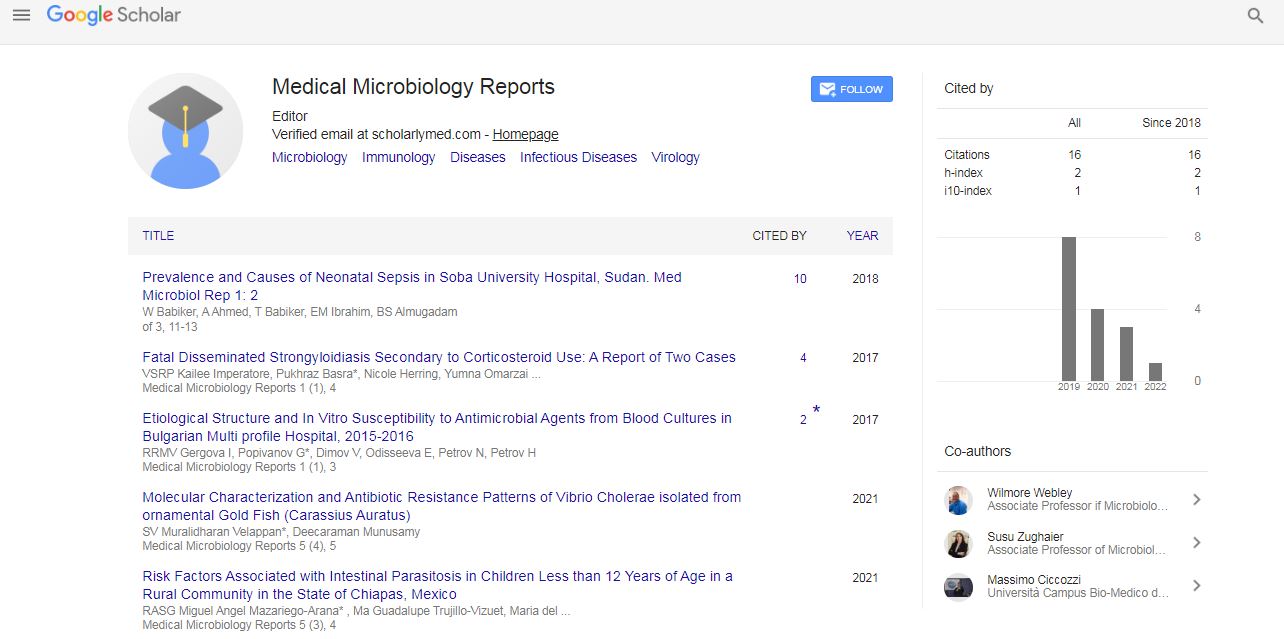Perspective, Med Microbiol Rep Vol: 7 Issue: 2
Typhus: Causes, Treatment, Prevention and Management
Sang Tsioutis*
Department of Internal Medicine, Kaohsiung Medical University Hospital, Kaohsiung, Taiwan
*Corresponding Author: Sang Tsioutis
Department of Internal Medicine, Kaohsiung Medical University Hospital, Kaohsiung, Taiwan
E-mail: santsio@gmail.com
Received date: 22 May, 2023, Manuscript No. MMR-23-107465;
Editor assigned date: 25 May, 2023, PreQC No. MMR-23-107465 (PQ);
Reviewed date: 08 June, 2023, QC No. MMR-23-107465;
Revised date: 15 June, 2023, Manuscript No. MMR-23-107465 (R);
Published date: 22 June, 2023, DOI: 10.4172/mmr.1000343
Citation: Tsioutis S (2023) Typhus: Causes, Treatment, Prevention and Management. Med Microbiol Rep 7:2.
Description
Typhus, a group of infectious diseases caused by different species of bacteria, has long been a persistent threat to public health. Despite significant advancements in healthcare and sanitation, typhus continues to afflict populations in various parts of the world, particularly in regions with poor living conditions and limited access to healthcare.
Typhus encompasses several distinct forms, including epidemic typhus (caused by Rickettsia prowazekii), murine typhus (caused by Rickettsia typhi), and scrub typhus (caused by Orientia tsutsugamushi). These diseases share common characteristics, including high fever, rash, headache and body aches. They are primarily transmitted to humans through the bites of infected fleas, lice or mites, which serve as vectors for the bacteria. In a few instances, transmission can also occur through direct contact with infected bodily fluids or contaminated materials.
Historically, typhus has had a significant impact on human populations, particularly during times of war, natural disasters and social upheaval. The disease has been responsible for devastating epidemics, such as the outbreaks that occurred in Europe during times of conflict and mass displacement, earning it the nickname "war fever." Overcrowded and unsanitary conditions, coupled with limited access to healthcare and proper hygiene, provide ideal breeding grounds for the vectors and facilitate the spread of typhus.
Despite advancements in public health measures, including improvements in sanitation and the availability of effective antibiotics, typhus continues to pose challenges in certain regions. Poverty, homelessness and inadequate healthcare infrastructure contribute to the persistence of the disease. Homeless populations, refugees and individuals living in crowded, unsanitary conditions are particularly vulnerable to typhus outbreaks. In areas with high rodent populations, murine typhus remains a concern, transmitted to humans through fleas that infest rats and other small mammals.
Early diagnosis and treatment are important in managing typhus situations. Antibiotics, such as doxycycline or azithromycin, are effective in treating typhus if initiated promptly. However, delays in diagnosis can lead to complications and potentially fatal outcomes. Recognizing the symptoms and risk factors of typhus is essential for healthcare providers to initiate appropriate treatment and implement control measures to prevent further transmission.
Preventing and controlling typhus requires a multifaceted approach. Efforts must focus on improving living conditions, addressing poverty and promoting access to adequate healthcare. Enhancing sanitation practices, particularly in crowded settings, is vital to reduce the population of vectors and minimize the risk of transmission. Education and awareness campaigns can help inform communities about the importance of personal hygiene, environmental cleanliness and the recognition of typhus symptoms.
Vector control measures play a vital role in preventing typhus transmission. Insecticides can be used to eliminate fleas, lice and mites that serve as vectors. Integrated pest management approaches, including rodent control measures, are essential in reducing the reservoir of bacteria and preventing the spread of murine typhus. Efforts should also focus on improving housing conditions and implementing effective measures to mitigate the risk of infestations.
International collaboration and support are important in addressing the persistent threat of typhus. Governments, healthcare organizations and global health agencies need to work together to strengthen healthcare infrastructure, enhance surveillance and reporting systems, and improve access to diagnostics and treatment in endemic areas. Sharing knowledge, resources and expertise can contribute to effective prevention and control strategies, reducing the burden of typhus on affected populations.
Conclusion
Typhus remains a persistent threat to public health, particularly in regions with poor living conditions and limited access to healthcare. The disease's historical significance and current challenges highlight the need for comprehensive approaches that address both social and environmental factors. By improving living conditions, implementing effective vector control measures, promoting hygiene practices and ensuring access to healthcare, people can mitigate the impact of typhus and work towards its eventual eradication.
 Spanish
Spanish  Chinese
Chinese  Russian
Russian  German
German  French
French  Japanese
Japanese  Portuguese
Portuguese  Hindi
Hindi 
